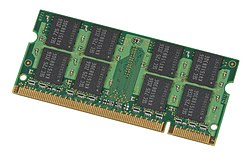| Type of RAM | |
 Front and back of a 2 GB PC2-5300 DDR2 RAM module for desktop PCs (DIMM) | |
| Developer | Samsung [1] JEDEC |
|---|---|
| Type | Synchronous dynamic random-access memory |
| Generation | 2nd generation |
| Release date | September 2003 |
| Standards |
|
| Clock rate | 100–266 MHz |
| Cycle time | 10–3.75 ns |
| Bus clock rate | 200–533 MHz |
| Transfer rate | 400–1066 MT/s |
| Voltage | 1.8 V |
| Predecessor | DDR SDRAM |
| Successor | DDR3 SDRAM |
Double Data Rate 2 Synchronous Dynamic Random-Access Memory (DDR2 SDRAM) is a double data rate (DDR) synchronous dynamic random-access memory (SDRAM) interface. It is a JEDEC standard (JESD79-2); first published in September 2003. [2] DDR2 succeeded the original DDR SDRAM specification, and was itself succeeded by DDR3 SDRAM in 2007. DDR2 DIMMs are neither forward compatible with DDR3 nor backward compatible with DDR.
Contents
- History
- Specification
- Overview
- Chips and modules
- Backward compatibility
- Relation to GDDR memory
- See also
- References
- Notes
- Further reading
- External links
In addition to double pumping the data bus as in DDR SDRAM (transferring data on the rising and falling edges of the bus clock signal), DDR2 allows higher bus speed and requires lower power by running the internal clock at half the speed of the data bus. The two factors combine to produce a total of four data transfers per internal clock cycle.
Since the DDR2 internal clock runs at half the DDR external clock rate, DDR2 memory operating at the same external data bus clock rate as DDR results in DDR2 being able to provide the same bandwidth but with better latency. Alternatively, DDR2 memory operating at twice the external data bus clock rate as DDR may provide twice the bandwidth with the same latency. The best-rated DDR2 memory modules are at least twice as fast as the best-rated DDR memory modules. The maximum capacity on commercially available DDR2 DIMMs is 8 GB, but chipset support and availability for those DIMMs is sparse and more common 2 GB per DIMM are used.[ citation needed ] [3]




